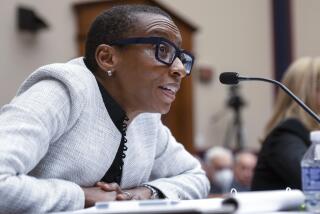ART : Have Forgers Finally Met Their Match? : A new digital registration process could discourage forgery and theft and help resolve disputes about authenticity and ownership of valuable artworks.
- Share via
SAN FRANCISCO — If a thief nabs your favorite Picasso or Diebenkorn painting and the police recover it, you probably won’t have much trouble identifying your stolen property--unless the artwork has been switched with a very good copy.
If, on the other hand, you lose an etching, lithograph, photograph, poster, bronze sculpture or medal--or any of a host of other collectible items produced as multiples--you may have considerable difficulty distinguishing your missing treasure from others that look exactly like it.
In either case, Verification Technologies Inc. has an answer for you. The Bay Area firm--established by San Francisco art dealers Stuart and Beverly Denenberg and John J. Christensen, a senior engineering associate at the University of California’s Lawrence Livermore National Laboratory--has developed a digital registration process that could help resolve disputes about authenticity and ownership of artworks while discouraging forgery and theft.
The recently patented process, promoted by its trademark acronym ISIS (Intrinsic Signature Identification System) and named for the Egyptian goddess of secrets, is based on the premise that all objects contain unique microscopic physical features and random anomalies that cannot be duplicated.
Fine art prints produced in a limited edition may look identical to the naked eye, but countless aberrations and irregularities inevitably occur during the printing process, Stuart Denenberg says. Similarly, commemorative medals stamped out by the same dye have individual peculiarities.
As for forgeries, even the most adroit craftsman can’t replicate microscopic variations that occur in multiples, Denenberg says. Nor can a forger produce a copy of a unique artwork that precisely matches the original in magnified details.
“As an art person, I know of differences between individual items in an edition of multiples,” he says. “But I didn’t expect the same richness of detail and differences in manufactured, mass-produced items. . . . There’s a huge landscape of anomalies.”
Christensen concurs: “We have tried to find objects that couldn’t be differentiated by our system, but we have failed miserably.”
Denenberg likens the system to “an electronic notary” or “a computerized fingerprint.” Color isn’t recorded during the registration process, he says, because it isn’t needed. Neither is high resolution required to reveal subtle differences between two objects.
“Once you are down there [at a high level of magnification], all you need is the lay of the land,” he says.
ISIS uses a high-powered video-microscope with an infinite zoom lens that can magnify and photograph details up to 2,000 times their actual size. These micro-feature images, or “virtual fingerprints,” are then formatted and encrypted onto a registration record using specially designed software. Finally, the images are stored in the firm’s computer archive, along with descriptive text. For security purposes, registration records are electronically backed up and stored on CD-ROMs at various locations.
Giving a demonstration in an office near his downtown San Francisco gallery, Denenberg Fine Arts, he points out differences in details of posters designed by artist Robert Rauschenberg, then moves on to dollar bills and medals.
Among fine artworks, Denenberg has registered items in Berkeley artist Edward Hagedorn’s estate, including two tiny etchings from an edition of “Jacob and the Angel Wrestling by the Sea.” Comparing magnified images of the heel of one of the angel’s bare feet, he reveals an array of disparities: minute dots of ink and cloudy configurations that appear in one image but not in the other, as well as variations in contours and crispness of lines.
ISIS is only the latest attempt to positively identify artworks in a continuing effort to stem the rising tide of art fraud and theft--which in dollar value is reportedly second only to crimes involving drugs. Several organizations, including the Art Loss Register in London, the International Foundation for Art Research Inc. in New York and law enforcement agencies, publish photographs and information about stolen artworks. Battling art crime on a global level, the J. Paul Getty Trust’s Art History Information Program is developing a broad-based international agreement on standards that will speed information about wayward cultural objects across national borders.
Additionally, various entrepreneurs have developed systems for identifying artworks by implanting radioactive isotopes into the surface of artworks, labeling them with invisible ink or encoding them with micro-crystals.
VTI’s founders say their system is much more effective. Tracking missing artworks is all to the good, Denenberg says, but it’s equivalent to locking the barn door after the horse is stolen. What’s needed is a registry so foolproof that it would deter thieves and make positive identification quick and easy.
Ordinary photographs are useful, of course, but they don’t illuminate microscopic details.
“All other attempts to register objects depend on changing the object, either by adding to it or taking something away,” Christensen says. “When we register an object, we don’t even have to touch it.”
The video-microscope can be positioned almost half an inch from the object’s surface, so artworks generally do not even need to be removed from their frames to be registered, Beverly Denenberg says. “It’s very easy to retrieve images. We can go through varnish and get the image through glass,” she says.
Recounting the tale of VTI’s evolution, Stuart Denenberg tracks the project back to 1981 when he was living in New York. Increasingly concerned about fraud and forgery, especially in the field of graphics, he conceived of a method to implant radioactive isotopes in artworks. “I thought that, bit by bit, museum by museum, we could build a global archive,” he recalls.
The idea was still fresh when he decided to present it at a 1982 meeting of the American Assn. of Museums in Washington. Denenberg wasn’t on the program, so he posted an announcement of a meeting that wouldn’t conflict with the planned agenda--at 7 on a Saturday morning.
“It was the least likely time for anyone to attend,” he says. “Amazingly, seven or eight people came, some from major institutions, including the Metropolitan Museum of Art in New York and the Library of Congress, and everyone was interested.”
Denenberg moved to San Francisco in 1982 and the idea lay dormant until 1990, when he represented an insurance company in an art fraud case. He discussed his idea with a forensic expert who was involved with the case and happened to work at the radioisotope laboratory at Livermore. “Not only did he not think the idea was crazy, he introduced me to John Christensen,” Denenberg says.
The two hit it off and began to brainstorm.
“We tried to define the problem and we came up with parameters,” Christensen says. “We decided we couldn’t add anything or remove anything to objects that were registered. That eliminated everything that had already been tried.”
Furthermore, they were determined to develop a system that made economic sense. “Ninety-five percent of all patents never show up in the market because they are ego-based,” Christensen says. “They are not economically viable.”
The team eventually concluded that an artwork’s micro-features could become its fingerprint and that if the features were recorded by computer, they could be recalled at almost any time or place. After about 2 1/2 years of work, they had developed the necessary software. Advances in electronic technology and storage capabilities made their system possible--and affordable, Christensen says. Registration fees range from $10 to $500 per item, depending upon the complexity of the job.
Verification Technologies Inc. was founded in 1993 with $125,000 in start-up money from friends and family and the help of an advisory board. Stuart Denenberg estimates that the firm eventually will need to raise $3.5 million to $5 million in venture capital to propel the system into a global enterprise.
At present, the project is in a developmental phase. The Denenbergs and Christensen are spreading the word by talking to leaders of auction houses, insurance companies and museums, as well as companies that might use the system to register inventories of jewelry and firearms.
“I think it’s a brilliant idea,” says Andrea Van de Kamp, senior vice president and managing director of Sotheby’s West Coast operations. But the auction house has not yet contracted for VTI’s services.
Apart from individuals who have registered single items--including a rare cello bow--the firm’s first client is Gehenna Press, a publisher of fine books and prints in Rockport, Me. Future clients will help fine-tune the process, offering input as they determine what they want to achieve.
One person who plans to be involved is Sarah Adams, a granddaughter of photographer Ansel Adams and co-owner of the Ansel Adams Gallery in Yosemite and Pebble Beach, Calif.
“I’m just beginning to learn about the system,” she says. “But I think it’s a fabulous idea because it offers a way to authenticate and identify each print precisely and to distinguish between two prints of the same image. . . . That could be a very useful service for a gallery to provide.”
How widely the system will be used remains to be seen, but Stuart Denenberg says the response has been encouraging: “I’ve been surprised by the acceptance of the process, once people understand it. If it’s described as a virtual fingerprint or virtual DNA, people get it.”
More to Read
The biggest entertainment stories
Get our big stories about Hollywood, film, television, music, arts, culture and more right in your inbox as soon as they publish.
You may occasionally receive promotional content from the Los Angeles Times.










